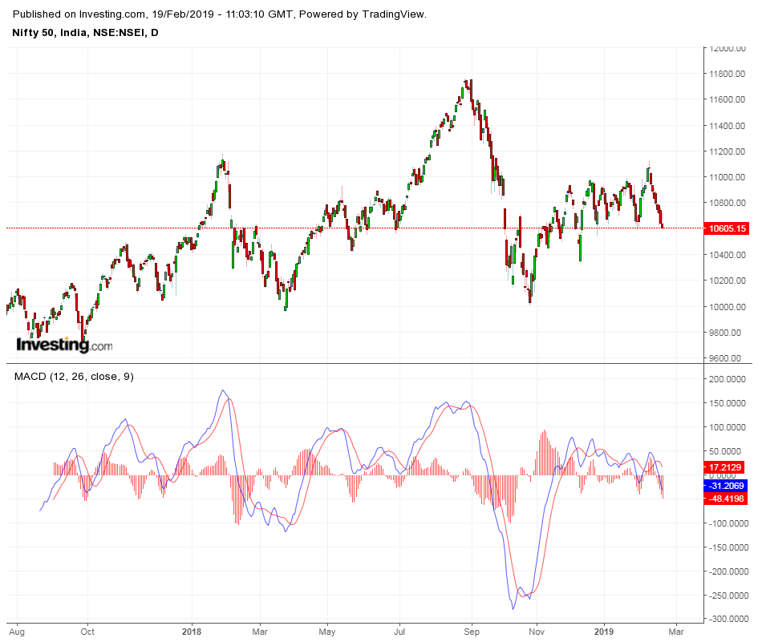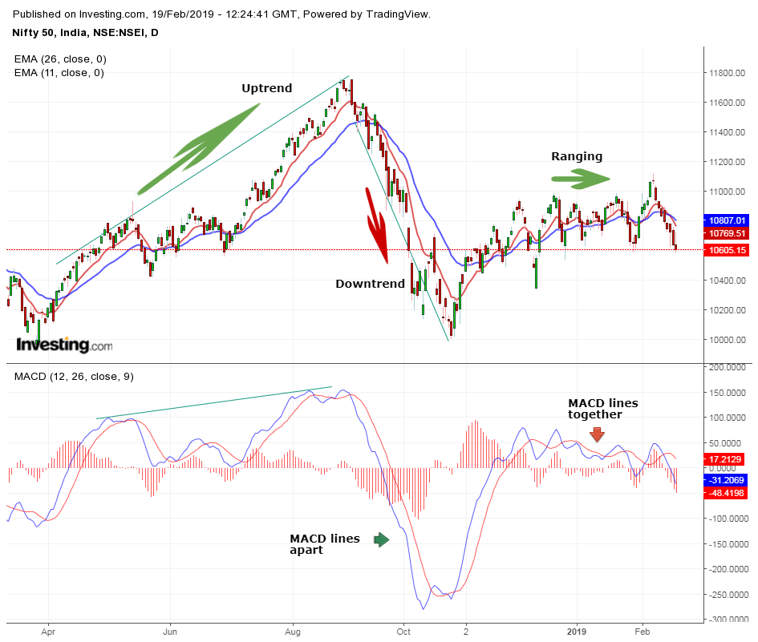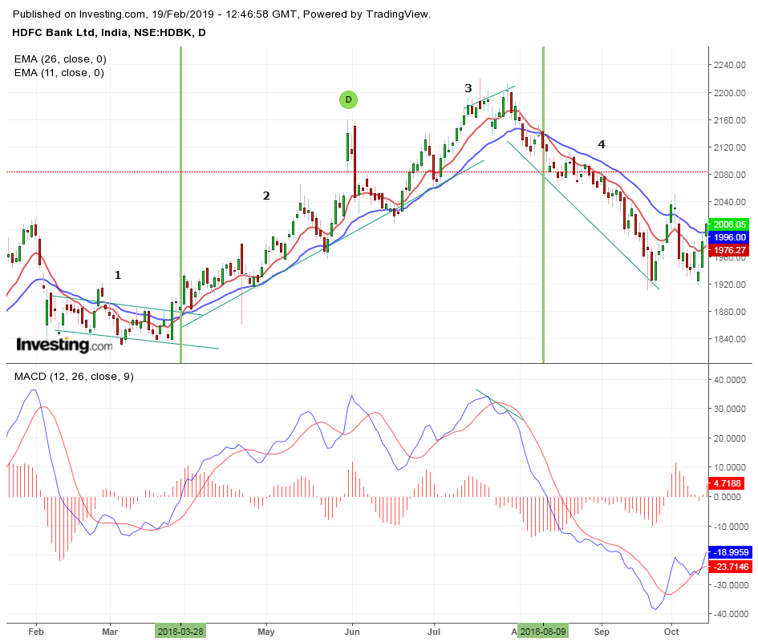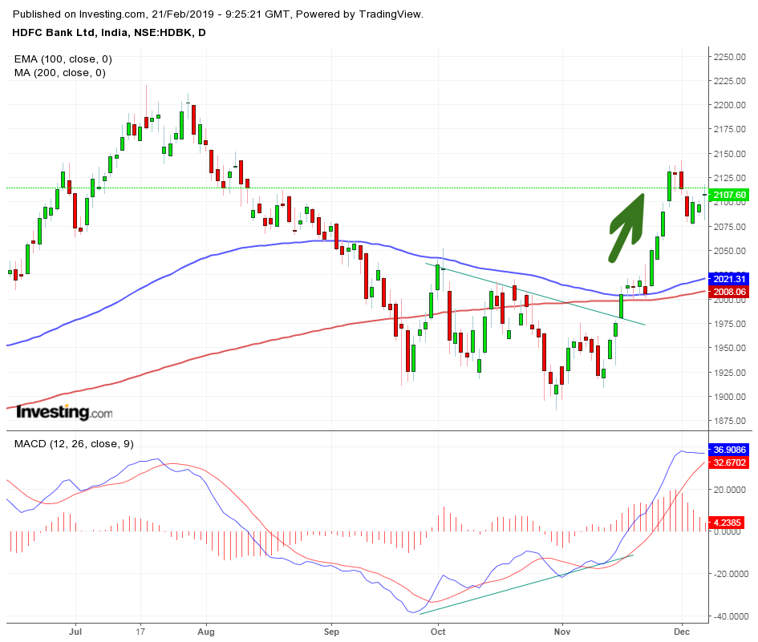Hindi: आप इस लेख को हिंदी में भी पढ़ सकते है|
The Moving Average Convergence Divergence that is the MACD indicator is a popular trend following and momentum indicator which is based on the information of moving averages and acts as an additional momentum tool as well as a momentum filter for trading.
“There is only one side of the market and it is not the bull side or the bear side, but the right side.” – Jesse Livermore
To completely understand this indicator one needs to first understand the concept of Technical Analysis. In this blog, we will explain what the indicator does, how it helps to analyze the price, and how to use it in your trading :
| Table of Contents |
|---|
| Components of the MACD indicator |
| MACD Indicator basics |
| What is Trend Following Entry? |
| MACD Divergences as Early Entries |
| MACD vs. Relative Strength |
| Limitations of MACD |
Components of the MACD indicator:
MACD Line: This line is an important part of the indicator and by default, it is the difference between the 12 period EMA and the 26 EMA period. This means the MACD line is basically a complete moving average crossover system by itself.
Signal Line: This is the 9 period EMA of the MACD line.
MACD Indicator basics :
As we have discussed above, the MACD is based on moving averages which means that it is ideal for analyzing momentum, finding trend following entries, and stays in trend until momentum dies off.
There are usually 2 MACD signals in particular which we will explore in this article and explain how to use MACD in order to find trades:
- The MACD line cross 0
I have also plotted the two moving averages, 12 and 26 EMA on the chart beside the MACD lines in order to explain how the MACD works.
When the 12 EMA crosses with 26 EMA below or above, the MACD also crosses 0 as well. Like said above, the MACD is itself its own moving average crossover system in just one line.
Learn to trade with market trend via MACD Indicator in just 2 hours by Market Experts

- The Signal Line
When we see that the two MACD indicator lines move away from each other, it means that the momentum is rising and the trend is getting stronger. When these two lines come closer to each other then it shows that the price is losing strength.
Note: As long as the price is above the 12 and 26 EMAs and the MACD lines are above 0 then the trend is still going on.

Trend Following Entry
Let us see how one can enter different phases of the market by understanding the Interpretation of MACD:
- Consolidation:
During ranges, the two MACD lines are very close together and they hover around 0, as we can see from the chart below. This means that there is neither momentum nor strength.
At point #1, the price also formed a narrow range. During a consolidation like a point 1, the MACD contracts sharply as well, and traders wait for the breakout of the wedge for a new trend to start.
- Uptrend:
When the price breaks out the wedge, EMA 26 crosses EMA 12 from below, MACD lines also separate with each other and move above 0. From the chart below we can see that at point #2 the two moving averages have separated from each other and crossed 0. That is the beginning of the new uptrend.
Also Read: What could be the leading indicator in technical analysis?
- Downtrend:
The divergence at #3 is a signal which we will explore below and it gave the early sign for the reversal. During downtrend #4 the price then again stayed below the moving averages and the MACD lines stay below 0.

MACD Divergences as Early Entries:
MACD divergences are a great way to analyze and find early trends following entries or exits.
You can see from the chart below how the price was moving lower very slowly over a long period of time. At the same time, the MACD moved higher showing there was no selling strength behind the slow grind.
Suddenly price broke above the moving averages while the MACD lines crossed above 0 and also separated further. This can be a signal of a new uptrend.

MACD vs. Relative Strength:
The relative strength indicator (RSI) aims to signal if a market is considered to be overbought or oversold in relation to recent price levels.
Whereas, MACD measures the relationship between two EMAs, while the RSI measures price change in relation to recent price highs and lows.
These two indicators are used together to provide analysts with a more complete technical picture of a market.
Limitations of MACD:
Divergence often signals a possible reversal but It may sometimes also produces a false positive.
The other problem is that divergence predicts too many reversals that don’t occur and not enough real price reversals.
Also, A slowdown in the momentum will cause the MACD to pull away from its prior extremes.
As with most of the indicators, we probably don’t need them when we read momentum information directly from the charts. But indicators can be a great tool for building confidence and creating objectivity in our trading.
However, never let anyone tell you that indicators don’t work. Yes, they do! It depends upon you how you use them.
Key Takeaways:
- The Moving Average Convergence Divergence that is MACD indicator is a popular trend following and momentum indicator
- MACD is based on moving averages which means that it is ideal for analyzing momentum, finding trend following entries, and stays in the trend until momentum dies off.
- When we see that the two MACD indicator lines move away from each other, it means that the momentum is rising and the trend is getting stronger
Happy Learning!






